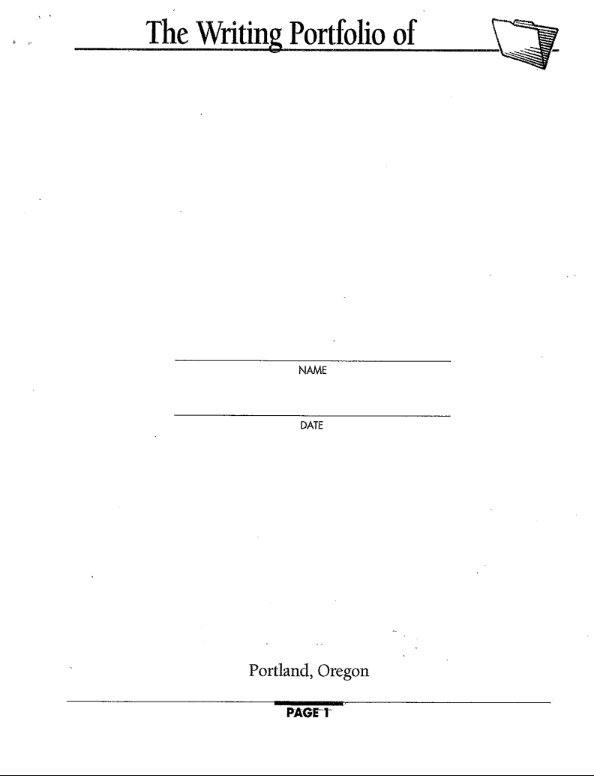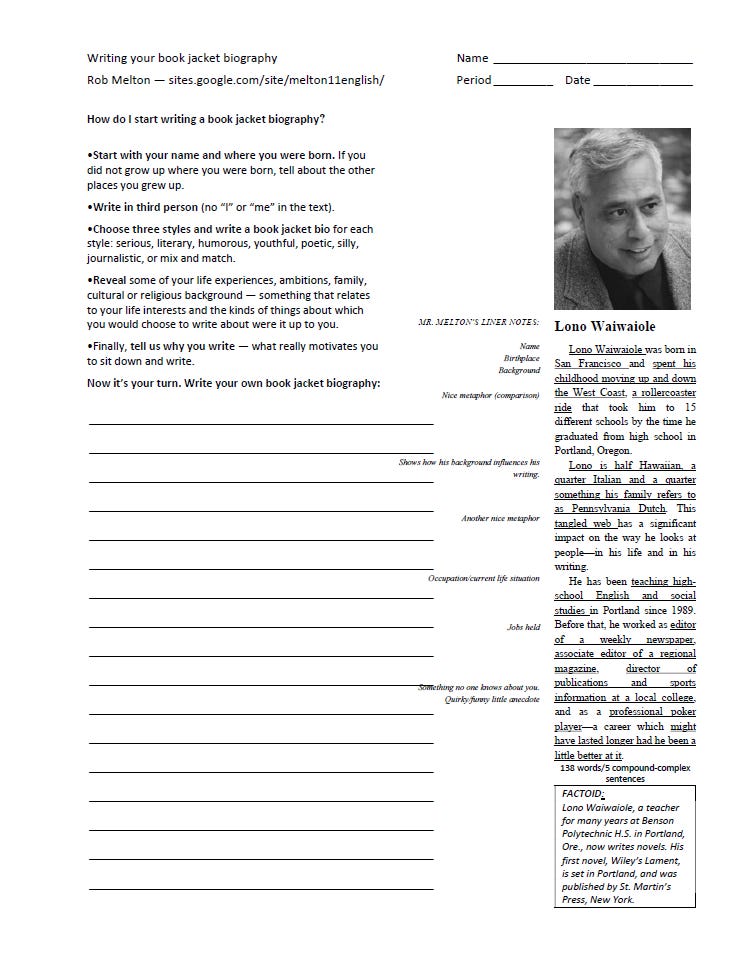Write before writing: Free students from failure, focus on learning, break content into genres, improve reading and writing, and use portfolio-based evaluation
Start the new year with three overarching lessons about writing, break your language arts study units into genres, and use a portfolio-based evaluation for grading. Everything you need is linked here.
I’ve been a fan of Donald M. Murray since I accidentally discovered this piece “Write Before Writing” in College Composition and Communication at the UO library as I was preparing to pivot from studying journalism at UO, to newspaper work, to teaching high school journalism and English.
It was the first academic article that read like it was written by a real writer. I’ve never seen a better explanation that reveals the real writing process.
This quick summary gives you the 40,000-foot view of Murray’s explanation of the writing process:
Prewriting definition: The moment the writer receives and idea or assignment and the moment the first completed draft is begun.
One principal negative force which keeps the writer from writing, and
Four positive forces which help the writer move forward to a completed draft.
1. Resistance to writing/The law of delay
2. Forces for writing
increasing information about the subject
increasing concern for the subject
aware of a waiting audience
an approaching deadline
3. Rehearsal/Thinking/Notetaking/Test drafts...
4. The signals which say write
Genre
Point of view
Voice
News
Line
Image
Pattern
Problem (to be solved)
As a public high school teacher in Oregon who believes in explicit teaching strategies, I typeset and designed it for students so it was cleaner and more readable, with a column on the sides for students to make notes, 3-5 to be exact. At the end I added 17 questions, or 29 possible responses, that required a close reading of and response to the text.

It is a transformative assignment, worth the time it takes to Read, Reflect, and Respond (my version of the 3R’s). Murray bridged the worlds of journalism and academic writing—the world I knew. (Journal, by the way, comes from an Old French word which meant daily, jour being the French word for day.) A brilliant journalist, coach, and scholar himself, he was instrumental in a school reform effort of the 1980s that focused on reflection.
At some point in my 41 years of teaching writing to high school and college students, I began searching for the origin of what I knew from Murray’s work.
I was unaware of that connection until today, when I found scholar Terry Underwood’s Substack and his article “Reclaiming the Lost Art of Teaching Writing: How Recent Educational Reform Derailed Decades of Progress and Assisted AI” in which he recounts the whole movement.
Today, I had that Aha! moment confirming my discoveries over the years of teaching public high school were not accidental—but were dismissed within a decade in the “standards” movement that has changed the conversation about local education results, and the inevitable hand-wringing that follows the release of the standardized scores each year.
It also forces the comparison between and within states that turns it into a one-winner-takes-all Super Bowl contest instead of a broad literacy movement tailored to the communities schools serve.
Eventually, I learned that students were not willing to risk failure if it was going to result in a “bad” grade, especially those who had a lot of ground to make up by the time I was their teacher.
To transition students to take the risk and invest in growth and discovery as a writer, which Murray discusses, I made them a deal that eased their fear of failure. An end-of-the-semester portfolio of their work, as well as a reflection essay about their own writing process growth and which pieces show that growth best.
I believe the portfolio completes the work Murray started, as reflection and discovery defeated the fear of failure once and for all.
It’s probably easier if I just post the portfolio end-of-semester project for you to see. It is based on what every journalist has—a string book of their best work—as well as their assessment of what it shows about their work. You will notice it explicitly lists every kind of writing a high school student is likely to produce.

The completed portfolio requires two additional pieces of writing—an author biography (I call it a book jacket bio to emphasize brevity), and a reflection on their writing process and growth (see rubric):

This is an overarching strategy for the whole semester/year designed to free students from “failure” and focus on learning. The second part of this strategy was to break down the study of traditional reading genres and turn them into active learning activities. Along with each of the genres is “Elements of…” reading provides a quick but thorough breakdown of every genre typically studied in high school and college.
My pitch, because you’ve got to sell it quickly, is that each of the Elements of documents provides everything they will ever need to know for high school and college English literature courses. As a bonus, they had the privilege of learning each genre by doing it.
In poetry, for example, we would study metaphor and compare some examples, and then they would write three of their own poems using metaphors. Their portfolio at the end of the semester included all of their written work, a reflective essay, and their assessment of their best work.
I always looked for “Elements of” documents I could use in books and libraries, and later on the web. When I couldn’t find anything, I wrote it myself. Eventually I found several sources that completed what the students needed to know. (These are available to examine and download here.)
It was like handing the Scope and Sequence document to your students instead of your principal. It essentially gave them the opportunity to demonstrate their growth as a student, which is the job description of a teacher.
They probably did more reading and writing than in other classes, but it was different. Assigning people into temporary project-based groups, sometimes of their own choosing, after my introductory lessons on the genre, provided me with time to personalize learning when table groups had questions.
I eventually limited my daily instructions to about five minutes, since I knew I would have to repeat them again anyway. They had their instructions, and if they had questions all they had to do was ask.
Often, in the middle of a lesson that was causing confusion, I would go into Coach mode. I would literally act like a referee and make a “T” with my hands and yell “Time Out!” and have a side discussion (coaching) to identify any problems and solve them before going “Back to work!”
Drama? Each group was assigned a scene to perform from the play. Poetry? We first read several poems in the style we were studying together and in table groups, analyzed them, and then they demonstrated what they learned by writing several of their own in the same style.
Then they would read their poems to their table group, choose the one they like best, and (preferably) have the author read the poem to the class. You can imagine how terrifying public speaking is for some people, so someone else would read it for them or I would. Often it was the shy students who had powerful things. Sometimes those students, observing the reaction of other students to their poems, would eventually volunteer to read them.
When students learn that you listen to their concerns and try to address them honestly and solve them in real time using their suggestions, lots of magic happens. They take ownership and ask for help. They begin to ask their own questions, and broaden their skills into public speaking, drama, film, and other genres that are sometimes not part of an English class.
Showing the connections to the real world, and how to do it, and how to perform it, and how to enjoy it and celebrate it makes all the difference in the world.
Elements of Narrative: The 5P's
This teacher-created overview of the elements of narrative makes it ideal for teaching students how to identify each of the five elements a writer has chosen to use for a given work, whether fiction or nonfiction. Each of the readings has a quiz and an activity (aka “test”) to demonstrate they have mastered the content of this handout. Then there is a w…
Elements of Poetry
Units of study are organized around genres, so of course each unit begins with a reading and a quiz about the breadth and depth of the genre. I’ve been fortunate to have found documents that served this purpose well, as well as receiving permission and support to use and adapt it in my classroom. When I haven’t found such documents, I…
Elements of film
Based on the book by John Golden as well as a workshop for PPS educators he presented at Grant H.S., Portland, Ore.
Elements of Typography
Typography is what helps you create text that just looks right — not to big, not too small, not to little white space, not too much. But it is much more detailed than that. Although this is for print, it is also about digital use of type. Type, after all is part of the design of any text-based media. But how do you decide what the look and feel of your …










Thank you for writing this! It was the propulsion I needed to finally get some Donald Murray books. I've been learning from a lot of people who have had Donald Murray as a mentor, and I think it's time to go to the source.